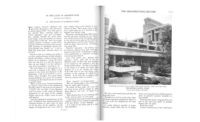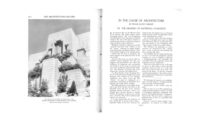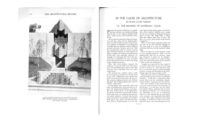Well – we may have the nobility of the material if nothing else.
We may have simple timer construction, at least over-head, as a scientific art, free of affectation. The wood let alone as wood or as richly ornamented by hand in color or carving.
We may have satin-boarded wainscots – polished board above polished board, the joints interlocked by beaded insertion, so that shrinkage is allowed and the joint ornaments the whole in harmony with its nature, individualizing each board.
We may have plaster-covered walls banded into significant color-surfaces by plain wood-strips, thick or thin, or cubical insertion, wide or narrow in surface.
We may have ceilings rib-banded in rhythmical arrangements of line to give the charm of timbering without the waste.
We may use flat wood-strips with silken surfaces contrasting as ribbons might be contrasted with stuffs, to show what we meant in arraign our surfaces, marking them by bands of sympathetic flat-wood.
We may use a plastic system of varying widths, weights of finely-marked wood rib-bands to articulate the new plastic effects in construction never dreamed of before. The flat-strip came so easily into our hands, by way of the machine, to give us – the “backband” that follows all outlines even in an ordinary dwelling, by the mile, for a few cents per tool.
We may compound composite-slabs of refuse lumber glued together under high pressure and press into the glue, facings of purest flowered wood veneer on both sides – making slabs of any thickness or width or length, slabs to be cut into doors, great and small, tops thin or thick – persevering the same flower of the grain over entire series or groups of doors as a unit, (see page 488).
We may mitre the flowered slabs across the grain at the edges of the breaks to turn the flowering grain around corners or down the sides and thus gain another plastic effect from the continuity of the flowering.
We may economically split a precious log into thin wide veneers and, suitably “backed,” lay each to each, opening one sheet to lay it edge to edge with the sheet beneath it, like the leaves of a book so the pattern of one becomes another greater pattern when doubled by the next.
We may cross-veneer the edges of top-surfaces so that the grain of the top carries the flower unbroken down over the ends as it does on the sides.
There is the flat fillet (it happens to be true to wood) to “talk” with – if one must “explain.”
We may use the plain-spindle alternating with the thin flat-slat or square or round ones in definite rhythms of light and shade – allowing the natural color and marking of the wood to enrich and soften the surface made by them as a whole. With this we may bring in the accent block.
We have the edgewise and flatwise-strip or cubicle stick and accent-block to “ingeniously” combine into screens for light-filters or for furniture.
These treatments all allow wood to be wood at its best and the machine can do them all surpassingly better than they could be done by hand – a thousand times cheaper.
Thanks to the machine we may now use great slabs compounded under heat and pressure, where rotary-cut veneer unrolled form a log in sheets ten feet long as wide as the circumference of the log will yield, in thicknesses of one-thirty-second of an inch, wood wall-paper. And we may lay these sheets, against various compounds, on ceilings – with any manipulation of the efflorescence, now exaggerated by the rotary cut, but still true to wood, and do this to any extent.
The finer properties of wood have been emancipated by the machine.
Observe that, naturally, all these are plastic effects. That is, used for the sake of the surfaces and lines of their “wood-quality” in contrast to other materials.
Carving has a small place in the grammar of these effects, except as an “insert.”
There is always the limiting frame or border, constricting surfaces – the most obvious of all uses to which wood is put. And there is always a use of the solid wood stick to be made into honest furniture. There is the wooden frame to be overstuffed for deep comfort – wood showing only at extremities. In light stick-furniture wood combines well with plaited rattan or raffia.
In other words the beauty of wood as silken-texture or satin-surfaces upon which nature has marked the lines of its character in exquisite drawing and color qualifying flat-surfaces and rib-bands of infinite delicacy, in all variety – because we work with the machine, understanding wood, is more liberally ours.
Another opportunity is wood-inlay. There is the chequered turning of the grain to crossgrain in the same wood.
There are the patterns of inlay in contrasting woods.
There are the cunningly cut, denticulated or machined strips to be inlaid between boards or used as edging flat surfaces of veneer: the denticulations to be picked out by polychrome in transparent bright stains, perhaps.
There is the whole gamut of transparent color stains from brilliant red, green, yellow and blue, to all hues in between, to aid and intensify or differentiate these uses of wood.
And for exterior work there are characteristic board-and-batten effects – horizontal, vertical, diagonal or checkered, got out of planks or boards with surfaces rough from the saw to be color-stained or allowed to weather.
There are roofs boarded lengthwise of the slope, likewise inlaid between the joints but with properly devised ornamental copper flashing to come up over the edges and the ends.
There are brilliantly decorative treatments of poles, free standing as the Alaskan totem stood, or in rows, horizontal or vertical. Palisaded walls.
There are combinations of slender pole and square-tick and the spindle-rod, alternating with the slat or the board in endless rhythmic variety.
All these undressed-wood, plastic treatments, are much the same as for inside work, allowing wood to be wood but coarser in scale with an eye to weathering in the joiner.
And finally after we have exhausted the board and machined inlaid-batten, and the spread of the figure of the wood-flowering over flat surfaces, and the combinations of the following back-bank and the varying rib-band – the spindle-stick, the flat-slab and the rod, the marking-strip and the accent-block, the ornamental-pole – rectangular timbering ornamentally planked, the undressed, interlocking boards on walls and roof slopes – then –
We have combinations of all these. A variety sufficient to intrigue the liveliest imagination for as long as life lasts – without once missing the old curvatures and imaging of organic-forms; the morbid twists and curious turns, the contortions imposed on wood in the name of the “Styles” mostly using wood as a makeshift – or, if not, as something other than wood.
A most proper use of wood, now that we must economize, are these treatment suing marking-bands or plastic-ribbons, defining, explaining, indicating, dividing, and relating plaster surfaces. It is economy in the material, while keeping the feeling of its beauty. Architectural-articulation is assisted and sometimes had alone by means of the dividing lines of wood.
In these plastic treatments – using wood gently banded or in the flat allowing tis grain and silken surface even in the spindle-screens to assert itself and wood-quality to enter into effect of the whole, we have found the Machine a willing means to a simple end. But for the Machine this free plastic use of wood either in rib-bands or extended flowered surfaces would be difficult, uncharacteristic and prohibitive in cost.
Moreover this is true conservation of wood because in these effects it is used only for its qualities as a beautiful material. The tree need no longer be lost.
In these papers we are not speaking of “building” as a makeshift, but of building as the Art of Architecture. And while all building, as things are, cannot be architecture but must make shift – architecture should hold forth such natural ways and means for the true use of good materials that, from any standpoint of economical realization of the best the material can give to structure, architecture would put mere building to shame. Stupid waste characterizes most of the efforts of mere builders, always – even or epically when, building for profit.
Wood grows more precious as our country grows older. To save it from destruction by the man with the machine it is only necessary to use the machine to emancipate its qualities, in simple ways such as I have indicated, and satisfy the man.
There is no waste of material whatever in such uses, either in cutting up the tree or adapting the cutting to the work done when it is of the character described. The machine easily divides, subdivides, sands and polished the manifold surfaces which any single good stick may be made to yield by good machine methods.
Wood can never be wrought by the machine as it was lovingly wrought by hand into a violin for instance, except as a lifeless imitation. But the beautiful properties of wood may be released by the machine to the hand of the architect. His imagination must use it in true ways – worthy of its beauty. His plastic effects will refresh the life of wood, as well as the human-spirit that lost it – as inspiration – long since.







